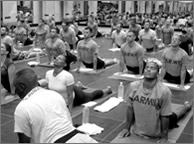 In my Wednesday night Discovery Yoga class, one of my students told me about a program she had heard on NPR that talked about Post-traumatic Stress Disorder (PTSD) and the use of yoga as a therapy in treatment. It turns out that the program was Krista Tippett’s “On Being,” a wonderful show of interviews that can be heard locally on Sunday morning from 7-8 am.
In my Wednesday night Discovery Yoga class, one of my students told me about a program she had heard on NPR that talked about Post-traumatic Stress Disorder (PTSD) and the use of yoga as a therapy in treatment. It turns out that the program was Krista Tippett’s “On Being,” a wonderful show of interviews that can be heard locally on Sunday morning from 7-8 am.
Ms. Tippett was interviewing the psychiatrist Bessel van der Kolk on her July 11, 2013 program. Dr. van der Kolk is a professor of psychiatry at Boston University Medical School and Medical Director in a community-based trauma center in Brookline, Massachusetts. He has spent much of his life researching traumatic stress and treating people suffering from PTSD.
In his work and research, Dr. van der Kolk found that people suffering from traumatic stress live with the “images or sounds or physical sensations” of the experience – they don’t go away. As a result, something changes in the brain so that the body in a traumatized state experiences the world as unsafe, frightening, even terrifying, even long after the original trauma.
The person with PTSD experiences these fearful emotions in his body. It is not surprising then to hear that such a person often lives out of touch with what is going on in his body; the strategy becomes a coping mechanism to deal with the emotions he feels. That was exactly what Dr. van der Kolk and his colleagues observed in people coming for treatment for PTSD – they were largely disconnected from their bodies.

Any of you who do yoga have most likely observed the calming, balancing effect of a good practice. This research documents the profound and transformational effects possible with the kind of engagement yoga demands. For the Western mind in the 21st century, this kind of research adds credibility to the insights of the ancients who always saw yoga as a tool for healing suffering.
This is just a short summary of this interview. If you would like to know more, the full transcript of this interview and the podcast can be found at OnBeing.org.
Please leave any comments, insights, or thoughts you have on this subject.
~